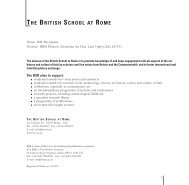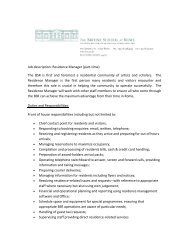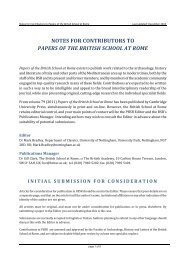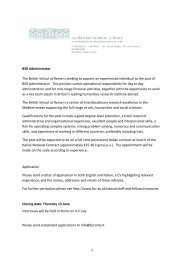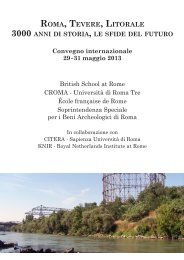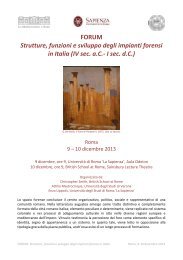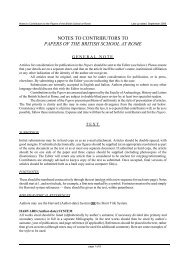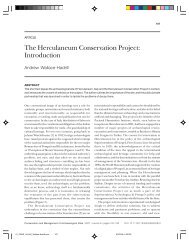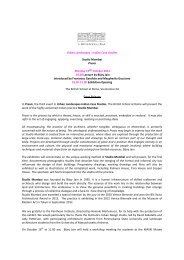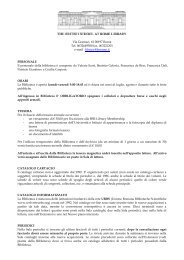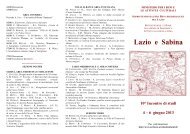fine ARTS 2010-2011 - The British School at Rome
fine ARTS 2010-2011 - The British School at Rome
fine ARTS 2010-2011 - The British School at Rome
Create successful ePaper yourself
Turn your PDF publications into a flip-book with our unique Google optimized e-Paper software.
Léa-C<strong>at</strong>herine SzackaROMA INTERROTTA 1978-<strong>2010</strong>: A RETROSPECTIVEHISTORICAL ANALYSISROMA INTERROTTA 1978-<strong>2010</strong>: UN’ANALISI STORICARETROSPETTIVARoma Interrotta was an endeavour, the raison d’être ofwhich was described by Giulio Carlo Argan as ‘a series ofgymnastic exercises th<strong>at</strong> Imagin<strong>at</strong>ion performs on theparallel bars of Memory.’<strong>The</strong> aim of this research was to reconstruct and furtheranalyse the history of one of the most importantarchitectural exhibitions of the twentieth century. In 1978, apressing need to rethink the city as a palimpsest urged agroup of 12 like-minded architects (Piero Sartogo,Costantino Dardi, Antoine Grumbach, James Stirling, PaoloPortoghesi, Romaldo Giurgola, Robert Venturi, Colin Rowe,Michael Graves, Leon Krier, Aldo Rossi and Robert Krier)to produce and exhibit a contemporary reinterpret<strong>at</strong>ion ofthe plan of <strong>Rome</strong> proposed in 1748 by Giovanni B<strong>at</strong>tistaNolli. Now an icon of the 1970s urban project, theexhibition Roma Interrotta, an initi<strong>at</strong>ive of the architectPiero Sartogo together with Graziella Lonardi Buontempo,a well-known Italian p<strong>at</strong>ron of the arts and the founder ofthe Incontri Internazionali d’Arte, was presented in thehistorical centrepiece of commerce and communic<strong>at</strong>ion ofthe Italian capital, the Markets of Trajan.Open just a few days after the assassin<strong>at</strong>ion of DC leaderAldo Moro, <strong>at</strong> a moment of major breakdown in the historyof contemporary Italy, the exhibition Roma Interrotta wasfirst and foremost a playful exercise meant to promote thefigure of the architect as an artist and an intellectual. Sortof architectural cadavre exquis, the exercise entailed a verystrong specul<strong>at</strong>ive and imagin<strong>at</strong>ive component: it was theidea of doing a project ‘as if’ the city had not changed inmore than 200 years, or, in other words, to canceleverything th<strong>at</strong> had happened to <strong>Rome</strong> between 1748 and1978. <strong>The</strong> idea for the show came from Piero Sartogo whohad travelled to Cornell University, Ithaca, where ColinRowe was leading the Urban Design Studio. <strong>The</strong>refore, theRoma Interrotta projects somehow derived from ColinRowe’s methodological approach called ‘designspecul<strong>at</strong>ions and fantasies on historic city plans.’As a result of this endeavour we are now left with a uniqueset of drawings of all forms shapes and n<strong>at</strong>ures. Witnesses ofan era, these drawings travelled the world in the l<strong>at</strong>e 1970s(from New York to Tokyo, London, Barcelona, etc.) beforebeing re-exhibited <strong>at</strong> the 2008 Venice ArchitectureBiennale. Interestingly enough, in 1979, famousarchitecture critic Ada Louise Huxtable had foreseen theRoma interrotta fu un tent<strong>at</strong>ivo la cui ragion d’essere fudescritta da Giulio Carlo Argan come ‘una serie diesercizi ginnici che l’immaginazione esegue alleparallele della Memoria’.Lo scopo di questa ricerca era ricostruire e analizzareulteriormente la storia di una delle più importanti mostredi architettura del XX secolo. Nel 1978, l’urgente necessitàdi ripensare la città come palinsesto spinse un gruppo di 12architetti di vedute affini (Piero Sartogo, Costantino Dardi,Antoine Grumbach, James Stirling, Paolo Portoghesi,Romaldo Giurgola, Robert Venturi, Colin Rowe, MichaelGraves, Leon Krier, Aldo Rossi e Robert Krier) a produrreed esporre una reinterpretazione contemporanea dellapianta di Roma realizz<strong>at</strong>a nel 1748 da Giovanni B<strong>at</strong>tistaNolli. Oggi un’icona del progetto urbano degli anniSettanta, la mostra Roma interrotta – inizi<strong>at</strong>ivadell’architetto Piero Sartogo insieme con Graziella LonardiBuontempo, nota mecen<strong>at</strong>e italiana e fond<strong>at</strong>rice degliIncontri Internazionali d’Arte – fu present<strong>at</strong>a nello storicocentro di commercio e comunicazione della capitale, iMerc<strong>at</strong>i di Traiano.Aperta solo pochi giorni dopo l’assassinio del leader DCAldo Moro, in un momento decisivo di rottura nella storiadell’Italia contemporanea, la mostra Roma interrotta fuprima di tutto un esercizio ludico destin<strong>at</strong>o a promuoverela figura dell’architetto come artista e intellettuale. Sorta dicadavre exquis architettonico, tale esercizio comportavauna componente specul<strong>at</strong>iva e immagin<strong>at</strong>iva molto forte:l’idea di fare un progetto ‘come se’ la città non fossecambi<strong>at</strong>a in più di 200 anni, o, in altre parole, dicancellare tutto ciò che era accaduto a Roma tra il 1748 eil 1978. L’idea della mostra venne da Piero Sartogo, che siera rec<strong>at</strong>o alla Cornell University, Ithaca, dove Colin Rowedirigeva l’Urban Design Studio. Pertanto, i progetti diRoma interrotta in qualche modo derivavanodall’approccio metodologico di Colin Rowe, definito‘speculazioni e fantasie progettuali sui piani urbani storici’.Quale risult<strong>at</strong>o di questa impresa ci resta un insieme unicodi disegni di tutte le forme e n<strong>at</strong>ure. Testimoni di un’epoca,questi disegni viaggiarono per il mondo alla <strong>fine</strong> degli anniSettanta (da New York a Tokyo, Londra, Barcellona, ealtrove) prima di essere nuovamente esposti nel 2008 allaBiennale di Architettura di Venezia. È interessante notareche, nel 1979, il famoso critico di architettura Ada Louise44Fine Arts <strong>2010</strong>-<strong>2011</strong>



